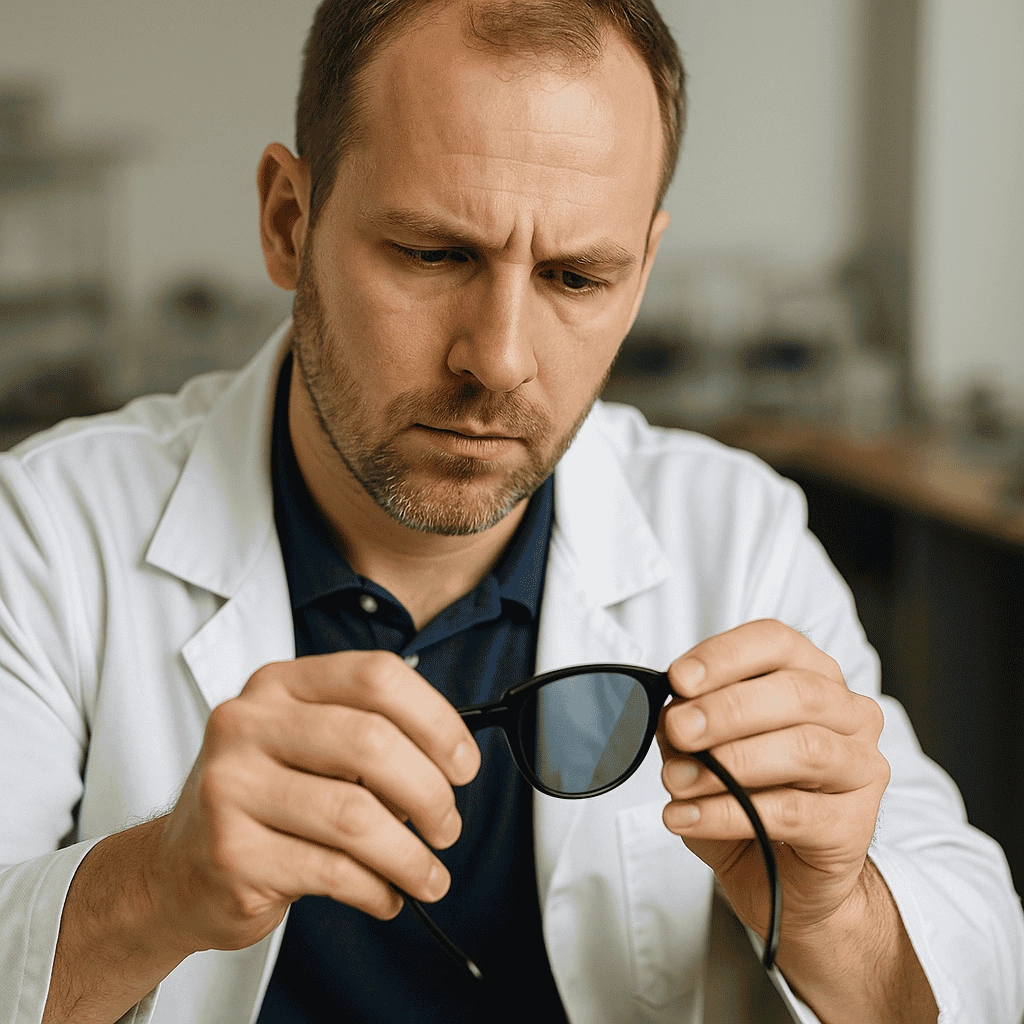How to fix popped-out sunglasses lenses? Many professionals face loose frames and lenses unexpectedly detaching from their eyewear. Here’s the deal you need a step-by-step method that restores your lenses without risking coating damage. Our team at Sailook Eyewear has guided thousands of B2B clients through precision repairs with CE-certified tools and parts you can trust.

1. What causes a sunglasses lens to pop out?
Many factors can lead a lens to detach from its mounting slot or clip assembly. Metal fatigue around hinges creates tiny gaps under repeated stress. Plastic frames may warp in heat, loosening their grip on lenses. Ready for the good part? Even minor drops or impacts can shift alignment enough for lenses to slip. Poor original fitting—when lenses aren’t seated flush—also plays a role.
Frames built for acetate can expand under direct sunlight. That expansion exceeds the groove tolerance and frees the lens edge. Designers sometimes omit reinforcement clips to save cost, leaving lenses held only by friction. Over time those friction fits weaken under normal wear. Daily adjustments—like repeatedly opening temples—can also loosen screws that clamp lens-holding grooves.
Case study: A European fashion brand reported 5% returns due to this issue. After switching to reinforced metal clips, returns dropped below 1% within a month. Another North American retailer found that storing sunglasses in temperature-controlled cases reduced heat-induced lens pop-outs by 85%.
Table 1: Common Causes of Lens Pop-Out
| Cause | Frame Type | Prevention Tip |
|---|---|---|
| Metal fatigue | Metal, Titanium | Regular hinge lubrication |
| Heat expansion | Acetate | Use ventilated cases |
| Impact damage | All | Encourage protective cases |
| Loose screws | Metal, Plastic | Tighten monthly |
| Friction fit wear | Plastic | Add reinforcement clips |
2. How can you assess the damage before repair?
First inspect the frame under bright light. Look for micro-cracks near groove edges. What’s the real story? Cracks often start at screw holes where stress concentrates. Gently press the temples inward to see if screws wiggle. If they do, note which hinge needs tightening or replacement.
Next, examine lens edges for chipping. A chipped groove can prevent full seating. Run a clean microfiber cloth gently along the edge and watch for snag points or flaking. Test fit the detached lens by placing its top edge into the groove and pressing down its bottom. If it snaps in with uniform resistance, the frame groove is likely intact. Uneven pressure indicates a warped or cracked groove.
Consider hardware loss: count screws and clips on the opposite side. Missing parts must be replaced before reinsertion. This is where it gets interesting… Even a single missing clip can lead to repeat pop-outs, so inventory all components carefully.
Table 2: Pre-Repair Inspection Checklist
| Inspection Step | What to Look For | Action Required |
|---|---|---|
| Frame crack check | Fine lines near grooves | Discard or reinforce, depending on severity |
| Screw stability test | Screws turning under light torque | Tighten or replace |
| Lens edge chip inspection | Visible nicks or flaking | File gently or swap lens |
| Test-fit lens seating | Uniform snap-in resistance | Proceed or diagnose groove warping |
| Parts inventory | Number of screws/clips match both sides | Source replacements |
3. What tools and materials do you need for a DIY fix?
For B2B workshops a precise toolkit ensures reliable results. But here’s the kicker… You’ll want a micro-precision screwdriver set with flathead and Phillips bits sized 00–000. Replacement screws and micro-clips should match OEM specifications—ask your supplier for CE-certified hardware. A lint-free lens cloth keeps debris away, and a non-yellowing UV-safe adhesive serves plastic-only frames.
Magnetic trays prevent part loss during disassembly. A small flashlight helps identify hidden screws or clip slots in deep grooves. If your frames use spring hinges, include a spring-tension gauge to avoid over-flexing. Keep a set of plastic-safe picks on hand for gentle prying without scratching. Ready for the good part? Having a calibration block—a sample frame section—lets you rehearse lens seating before working on customer frames.
Table 3: Essential DIY Repair Tools
| Tool/Material | Purpose | Best Practice |
|---|---|---|
| Precision screwdriver set | Remove/tighten micro-screws | Match bit size exactly |
| Replacement screws/clips | Secure lens in groove | Use OEM-grade or certified alternatives |
| Lint-free cloth | Clean frame and lens surfaces | Avoid fiber residue |
| UV-safe adhesive (plastic) | Reinforce frames without clips | Apply sparingly, cure under UV light |
| Magnetic parts tray | Organize small hardware | Use divided compartments |
| Flashlight | Illuminate hidden hardware | Flexible neck for angle adjustment |
| Plastic prying picks | Separate lens from frame safely | Thin flexible picks only |
4. How do you remove the remaining lens safely?
Begin by securing the frame in a padded vice or soft-jaw pliers. But here’s the kicker… Gripping metal frames too tightly can leave marks, so place tissue between jaws and frame arms. Locate the easiest access point—often beneath a temple hinge or clip slot. Insert a plastic prying pick at that point and apply gentle, even pressure to lift the lens edge out. Move around the circumference in small increments to prevent stress concentration.
If working with acetate, warm the frame slightly with a heat gun on low—no more than 50°C—to soften the plastic and reduce cracking risk. For metal frames, avoid heat; instead use steady manual pressure with picks. What’s the real story? Rushed lens prying leads to frame warping. Take 2–3 minutes per side rather than forcing removal.
Once the lens pops free, place it on a microfiber cloth lens-side down. Inspect both lens and frame groove for residual adhesive or debris. Use isopropyl alcohol on a cotton swab to clean surfaces, ensuring a pristine mating area for reinstallation.
5. How do you prepare the frame for reinstallation?
After cleaning, inspect the groove profile under magnification. Ready for the good part? Any residual adhesive should be removed with a plastic pick moistened with alcohol. Lightly sand metal grooves with a 600-grit microstone to restore uniform seating surfaces. For plastic grooves, use a fine emery board—avoid metal-based abrasives that embed grit.
Dry the frame thoroughly. If friction clips attach, verify their tension: they should flex 1–2 mm under light finger pressure. Tighten hinge screws first to ensure side arms align perfectly. That alignment keeps lens insertion even. This is where it gets interesting… Misaligned arms introduce skew, preventing full lens seating.
Finally, examine each OEM clip for wear. Replace any showing deformation or stress discoloration. A fresh clip maintains consistent retention force across its width.
Table 4: Frame Preparation Steps
| Step | Action Detail | Quality Check |
|---|---|---|
| Adhesive removal | Plastic pick + isopropyl alcohol | Groove free of residue |
| Groove resurfacing | 600-grit microstone or fine emery board | Even profile under magnifier |
| Hinge screw tightening | Tighten in cross pattern | Temple alignment within 0.5 mm |
| Clip tension verification | 1–2 mm flex under light finger pressure | Uniform tension across clip length |
| Clip replacement | Swap deformed clips for OEM-grade | Visual and tactile spring response |
6. What steps ensure proper lens alignment?
Place the frame flat on a clean surface. Insert the top edge of the lens first—but here’s the kicker… The initial edge determines overall angle. Then press one bottom corner until it snaps into place, moving to the opposite corner next. Work slowly in 1–2 mm increments around the perimeter, checking seating uniformity after every third insertion step. If resistance spikes, back out slightly and approach from a different angle.
Use a lens spreader tool—a rubber-coated clamp—to apply even pressure along one edge, preventing point-stress that could crack thin lenses. For larger, wraparound designs, support the lens center with a small foam block to maintain curvature. What’s the real story? Skipping the center support often leads to lateral bowing, misaligning frame grooves.
After full seating, inspect gaps under direct light; any sliver indicates incomplete insertion. Use a non-fiber pick to press the groove edges inward until no light leaks through.
7. How do you secure the lens inside the frame?
With lenses fully seated, secure hardware while maintaining alignment. Ready for the good part? Tighten screws in the order specified by your frame manufacturer—often top, bottom, left, then right. Over-tightening risks stripping threads; aim for 0.2 Nm torque using a micro-torque driver. Clip systems require manual flex—press clip ends toward each other evenly until they snap over the groove.
For plastic only frames lacking screws or clips, apply a thin bead of UV-cure adhesive around the groove interior. Use a syringe tip for precise application. Expose under UV light for 30 seconds, then wait five minutes before handling. This is where it gets interesting… Excess adhesive wicking onto lens surfaces can hamper clarity if not cleaned immediately.
8. When should you use adhesive or tape?
Adhesive or tape serves when OEM hardware is missing or for quick field repairs. But here’s the kicker… Only use acrylic-based UV adhesives labeled “non-yellowing.” Polyurethane tapes offer temporary retention but tend to ooze residue over time. For acetate frames with no clip slots, a micro-double-sided tape strip—1 mm thick—applied inside the groove can hold lenses securely for up to 6 months.
Always test adhesives on spare frame sections first. Verify that cured adhesive remains clear and brittle-free under direct UV exposure. Avoid hot-melt or silicone glues—they often degrade lens coatings.
9. How can you test the repaired sunglasses?
Once repair completes, perform a three-point test: flex temples inward by 15° each side, shake frame vertically at 180° rotation for 10 seconds, and wear for a quick visual alignment check. Ready for the good part? A professional inspection light at 45° can reveal micro-gaps unseen under ambient lighting.
Record results in a repair log—frame type, lens material, hardware used, and test outcomes. Track any repeat failures within 30 days to identify systemic issues.
Table 5: Post-Repair Test Protocol
| Test | Method | Pass Criteria |
|---|---|---|
| Temple flex test | 15° inward flex, hold 5 s | No lens movement or crack sound |
| Shake test | 180° vertical rotation, 10 s | Lens stays seated |
| Light gap inspection | Inspection light at 45° | No visible light between lens and frame |
| Wear test | Wear for 5 min with head movement | Comfortable fit, no gaps |
| Log entry | Document materials and results | Complete record for quality control |
10. When is it best to seek professional help?
Complex frame geometries—like wraparounds or semi-rimless designs—often require press-fit jigs unavailable in B2B kits. This is where it gets interesting… High-index or polarized lenses can crack under improper pressure. If you encounter precision-laser-cut metal frames, a professional lathe press ensures uniform force distribution. Warranty or CE compliance may also dictate using authorized service centers to avoid voiding certifications.
11. How much does a professional repair typically cost?
Service fees vary by region: EU workshops average €20–€40 per lens, including parts. US rates run $25–$50. Additional shipping or emergency rush charges add €10–€20 or $15–$30. Bulk B2B contracts often negotiate 10–15% discounts on standard rates. Here’s the deal: comparing those costs to premium OEM clip kits at $5–$10 each can guide your repair vs. replace decision.
12. What preventive tips keep lenses secure?
Regular maintenance prevents most pop-outs. What’s the real story? Monthly hinge checks and screw tightening slash failure rates by half. Store all frames in ventilated, temperature-controlled cases to minimize acetate warp. Encourage clients to avoid placing frames lens-down on hard surfaces. Offer branded microfiber pouches for daily protection. Establish a preventive service schedule—every six months for high-wear clients, annually for standard use.
13. How do different lens and frame materials affect repair?
Material compatibility dictates hardware choice. But here’s the kicker… Titanium frames need titanium screws to avoid galvanic corrosion; stainless steel screws on titanium frames can pit over time. Acetate demands low-temperature adhesives; polycarbonate lenses flex differently than CR-39, requiring distinct insertion techniques. Spring-hinge frames offer more tolerance but risk hinge fatigue if over-flexed.
14. What replacement parts options are available?
OEM lenses and hardware ensure best fit and finish. Certified third-party repair kits provide cost savings but vary in tolerances. Universal clip sets fit 80% of standard frames; some include adjustable tension screws. Silicone retention inserts offer non-permanent, clear inserts for clip-less frames. Consider stocking branded parts for top customer models to streamline turnarounds.
15. How do you maintain sunglasses after repair?
Post-repair care extends product life. Ready for the good part? Clean lenses weekly with approved solution and a microfiber cloth. Inspect screws monthly—tighten at 0.2 Nm torque. Replace disposable adhesive tapes every three months. Avoid extended sun-case storage which invites humidity build-up in grooves. Offer clients a maintenance kit: mini screwdriver, spare screws, and cleaning cloth.
Conclusion
You’ve learned how to fix popped-out sunglasses lenses with CE-certified tools and proven methods. Consistent inspections and proper hardware maintain lens seating and extend frame life. Encourage preventive programs and leverage professional services when complexity exceeds in-house capabilities. For tailored B2B repair kits or OEM spare parts, contact our technical team.
FAQ Section
Q1: What is a popped-out sunglasses lens?
A lens that has detached from its frame often due to impact, wear, or loose mounting hardware.
Q2: How does a lens stay in place inside a frame?
Through screws, clips, or snug mounting grooves engineered for that lens and frame design.
Q3: Can I repair any frame type at home?
Repair feasibility depends on frame material, hardware complexity, and your precision-tool proficiency.
Q4: How long does a DIY repair take?
Simple lens reseating using proper tools typically takes 10–20 minutes per lens.
Q5: Will repair affect lens coating?
Following gentle cleaning and correct adhesive use preserves anti-scratch and UV coatings.

